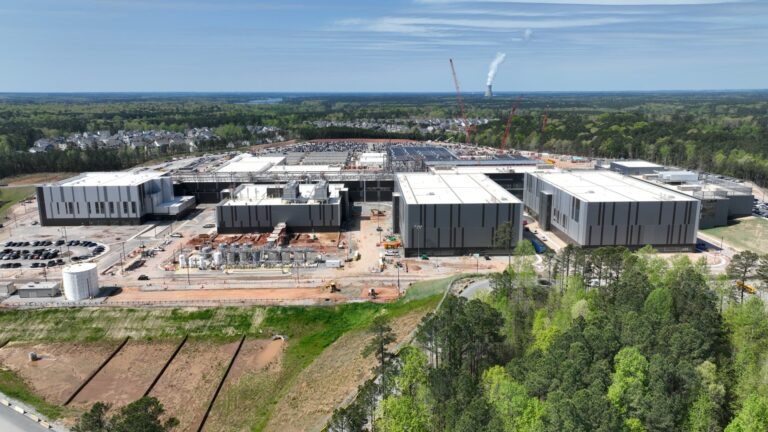
HOLLY SPRINGS, N.C. — A hallway as long as three football fields connects four buildings at Fujifilm Biotechnologies’ new biologics manufacturing plant in Holly Springs, North Carolina.
The first two buildings are preparing to open this fall to produce drug substance, essentially the base of biologic drugs, for Fujifilm’s initial customers Regeneron and Johnson & Johnson. The second two facilities are still under construction, with plans to open in 2028.
Fujifilm’s timing couldn’t be better, as President Donald Trump threatens to impose tariffs on pharmaceuticals to encourage companies to make more medicines in the U.S. But the plans for this complex were underway well before Trump proposed higher duties.
It’s taken five years and more than $3 billion to turn the idea into reality. And it shows how difficult it would be for drugmakers to quickly increase production in the U.S., even with a possible grace period that Trump has floated.
“This is a pharmaceutical manufacturing facility, so everything needs to be safe to put into patients,” said Fujifilm Biotechnologies CEO Lars Petersen. “Everything requires an extreme high technology level, very high cleanability. Everything needs to be documented, everything needs to be approved later on by the authorities. So that process is just extremely tedious.”
As companies move to set up more U.S. manufacturing, tariffs may not end up being as big a problem for them as previously thought. The Trump administration on Thursday clarified that under its trade framework with the European Union, pharmaceuticals coming from the bloc would be subject to only a 15% tariff, not a higher one the administration may implement on medicines more generally.
Fujifilm’s timeline for opening the Holly Springs site is in line with the industry average of between three and five years to start up a new plant, depending on the complexity, according to Gabriela de Almeida, managing director and partner at Boston Consulting Group. It helps that the new facility is identical to the one Fujifilm operates in Denmark.
The company decided to start replicating its plants to speed up the process of designing and building them. The more Fujifilm does that, the faster it can open new sites and customers can start production there, Petersen said. Even once the first tenants move in this fall, they’ll need the U.S. Food and Drug Administration to sign off before they can use the products that are made here.
Biologics are particularly complex drugs to make because they rely on living cells to produce the exact same thing, every single time, said Regeneron CEO Len Schleifer.
“It’s very expensive, very complicated and takes a very long time,” Schleifer said.
When all four buildings are open in 2028, the plant should have the capacity to produce 50 million doses of medicine a year with 16 bioreactors that can each hold 20,000 liters. The companies won’t say exactly which drugs will be made at the facility, but is designed to produce monoclonal antibodies.
It takes almost two months to produce one batch of bulk drug substance. The process involves growing cells that are making a desired protein, purifying the resulting material then preparing it to go to the next step in the complex pharmaceutical supply chain. Opening a valve at the wrong time and letting just one wrong molecule inside could mean an entire batch is lost, Fujifilm’s Petersen said.
Why drugmakers are boosting U.S. manufacturing
FUJIFILM Diosynth Biotechnologies in Holly Springs, North Carolina.
Courtesy: FUJIFILM Diosynth Biotechnologies
Regeneron, one of the largest producers of biologic drugs in the world, signed a $3 billion, 10-year contract with Fujifilm for space at the new Holly Springs site, doubling its U.S. manufacturing capacity. By the time Regeneron was looking to increase production, Fujifilm had a head start of multiple years in constructing the facility, so it made sense for the biotech company to secure space there instead of building from scratch, Schleifer said.
Regeneron declined to specify which drugs it will produce in Holly Springs. The company manufactures its medicines at a mix of locations, including its own factories in the U.S. and Ireland, according to regulatory filings. Regeneron is also in the process of opening a new plant in New York, and it acquired another property in that state that it may use for manufacturing.
It’s one of a number of biopharmaceutical companies that have recently announced plans to increase U.S. production of pharmaceuticals as Trump pressures them to make more of their drugs domestically.
Drugmakers were already ramping up their U.S. manufacturing capabilities before Trump started threatening tariffs specifically on pharmaceuticals, which he exempted from sweeping levies on dozens of countries this spring. The number of U.S. biopharmaceutical manufacturing facilities in the country has increased more than 50% since 2018, according to data from the Pharmaceutical Research and Manufacturers of America, the industry’s main lobbying group.
Johnson & Johnson Chief Financial Officer Joe Wolk said changes in U.S. tax policy made the U.S. a more attractive place to produce drugs. The company signed a $2 billion, 10-year deal to secure space at Fujifilm’s Holly Springs site as part of its $55-billion commitment to invest in the U.S. in the coming years. Those moves will allow J&J to supply all of its advanced medicines from the U.S., Wolk said, while declining to name which drugs will be made at Fujifilm’s facility.
“It really comes down to good tax policy,” Wolk said. “If you think about the tax policy that’s now in place at the United States at a 21% [corporate] tax rate, that puts us right in the middle of the pack,” allowing J&J to tap into the infrastructure that’s emerged in the U.S. since the 2017 Tax Cuts and Jobs Act, he said.
North Carolina has benefited from the boom. Life sciences companies have announced about $28 billion of investments in the state since 2016, with a record $10.8 billion pledged last year, according to the North Carolina Biotechnology Center.
Down the street from Fujifilm’s new facility in Holly Springs, Amgen is building a $1 billion drug substance manufacturing plant, following another it opened there in January. Genentech will break ground later this month on a $700 million fill-finish facility, where injectable drugs are packaged into containers like vials.
“It’s talent,” said Laura Rowley, vice president of life science economic development at the North Carolina Biotechnology Center, about what’s driving companies to the state. “It is being here amongst their peers, where there is opportunity still for companies to shine, because we do have that spirit of working together.”
Playing catch up
FILE PHOTO: A view shows the Fujifilm Diosynth Biotechnologies’s facilities in Stockton-on-Tees, Britain January 29, 2021.
Lee Smith | Reuters
Biopharma companies are moving to the U.S. to make innovative products with high margins that can withstand the higher cost, BCG’s Almeida said. But catching up will take time.
Only 18% of finished generic and branded drugs originate in the U.S., excluding Puerto Rico, according to an analysis of 2024 Food and Drug Administration pharmaceutical import data by the U.S. Pharmacopeia, an organization that aims to improve the drug supply chain. The country of origin refers to the country where the last major manufacturing step occurred, typically where the active pharmaceutical ingredient was produced.
For branded injectable medicines – like the ones that will be made at Fujifilm’s Holly Springs facility – Europe is the dominant source, with almost half originating there.
Securing manufacturing capacity in the U.S. with a contractor like Fujifilm is one tweak companies can make to reduce their potential tariff exposure in the short term, said Greg Graves, a senior partner in McKinsey’s life sciences practice. Signing on with an external site could be quicker and less expensive than building a new plant.
Simply moving manufacturing to an existing space can take two to three years, BCG’s Almeida said. Called a tech transfer, the process of producing a drug in a new location requires planning, testing to prove the new process works the same, then seeking approval from regulators.
Regardless, every company is trying to figure out how to prepare for tariffs, Almeida said. Graves and fellow McKinsey senior partner Parag Patel are seeing the same among their clients. However, they said, no one is preparing for a rate as high as 250%, a possibility Trump raised earlier this month.
“I haven’t come across any organization that’s going that big in their planning because I think they all understand that if this happens, it would fundamentally change the way we’re organized and running, and therefore we’d have to have a different conversation,” Patel said.
At Fujifilm’s Holly Springs site, the whole point is to give customers flexibility, Petersen said. There’s room to double the entire site, a decision the company will make if the demand warrants it. Should Fujifilm decide to move forward, Petersen thinks it can build that in just three years this time, since the company’s getting faster with each facility clone it creates.
“There’s no question that when you have these discussions like tariffs or like Covid or like any other disruption to the supply chain, it creates a need for flexibility,” Petersen said. “This facility was built before some of these discussions, but it’s definitely built to handle supply chain ability should demand go up or down.”


